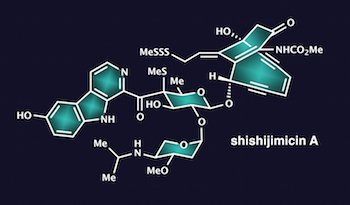Chemist K.C. Nicolaou and team achieve first total synthesis of shishijimicin A
Rice University scientists have achieved the total synthesis of a scarce natural marine product that may become a powerful cancer-fighting agent – the molecule shishijimicin A.
A group led by world-renowned Rice chemist K.C. Nicolaou announced the successful synthesis this month in the Journal of the American Chemical Society.

The molecule known as shishijimicin A, discovered more than a decade ago in a marine animal known as a sea squirt and found to be highly toxic to cancer cells, has been synthesized by the Rice University laboratory of chemist K.C. Nicolaou. Click on the image for a larger version. Courtesy of K.C. Nicolaou
The complex organic molecule was discovered in a rare sea squirt, Didemnum proliferum, more than a decade ago. Lab tests at the time proved it to be more than 1,000 times as toxic to cancer cells as the anticancer drug taxol (aka paclitaxel), but its scarcity did not provide amounts sufficient for extensive biological studies and clinical trials.
For that, chemists needed to design and develop the many steps required to synthesize the molecule, a specialty for which Nicolaou is well-known. Nicolaou, who joined Rice in 2013, is noted for achieving the first synthesis of taxol as well as the synthesis of the highly cytotoxic compound calicheamicin, which was used in the first antibody-drug conjugate (ADC) for targeted chemotherapy.
Nicolaou said shishijimicin shows just as much potential – and perhaps more – for cancer treatment via “Trojan horse”-style ADCs tuned to target specific types of cancer. “Because it’s so potent, you may only need one or two molecules to get into a cancer cell to do the job,” he said.
Such toxins kill cancer cells by cleaving their DNA or freezing their cytoskeletons to prevent them from replicating, he said.
The path to synthesis took a rapid two years because much of the groundwork had already been set by Nicolaou’s basic work three decades ago in the total synthesis of calicheamicin.

Rice University researchers have achieved total synthesis of shishijimicin A, which shows potential as a powerful cancer-fighting agent. From left, Zhaoyong Lu, James Woods, K.C. Nicolaou, Ruofan Li and Te-ik Sohn. Photo by Jeff Fitlow
“All the fundamental science for the shishijimicin project was done in the 1990s,” he said. “What we synthesized then was too toxic to be used, but now it has revitalized the whole field because biologists and clinicians can selectively target cancer cells (with ADCs). If we hadn’t done the fundamental science so many years ago, it would have taken us so much longer to come to the same point.”
Nicolaou said his prime concern, in addition to facilitating biology and medicine, is to advance the field of synthetic chemistry. “If we don’t advance it now, we won’t be able to make the complex molecules of the future,” he said. “We have to continue to sharpen the tools of organic synthesis.”
Nicolaou said the next steps for shishijimicin are to streamline its synthesis and add chemical handles so it can be attached to antibodies for delivery to cancer cells. “We’ve established the beachhead with the first total synthesis,” he said. “Now we aim to optimize the process to make it more practical and apply it to synthesize variations of the molecule.”
Then it will be up to partner pharmaceutical companies to develop the compound for eventual clinical trials. They won’t need much, Nicolaou said. “If they have a few hundred milligrams – a fraction of a gram – they can take it to clinical trials, because it’s so potent,” he said. “And now they have hundreds of antibodies selected for different kinds of cancer. My hope is that our molecule will lead to an effective drug for personalized medicine.”
Rice postdoctoral researchers Zhaoyong Lu, James Woods and Te-ik Sohn and graduate student Ruofan Li are co-authors of the paper. Nicolaou is Rice’s Harry C. and Olga K. Wiess Professor of Chemistry.
The Cancer Prevention and Research Institute of Texas and the Welch Foundation supported the research.


Leave a Reply